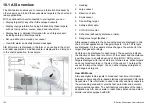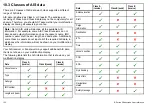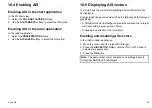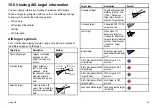
9.11 Using radar to track targets and
avoid collisions
There are a number of radar functions to help you track targets and
avoid collisions, including Guard Zones, MARPA, and AIS.
With a radar connected to your multifunction display, you can:
• Assess how far away a target is and its bearing (VRMs/EBLs).
• Set an alarm to trigger when a target is within a specified zone
(Guard Zones).
• Display detailed information on tracked targets (MARPA).
• Display the identity of other vessels and if broadcasted, their
voyage information (AIS).
• Display the range and bearing of a target.
Setting up a radar guard zone
In the radar application:
1. Press the
TARGET TRACKING
softkey.
2. Press the
MONITOR IN ZONES
softkey.
3. Press the
ZONE 1
or
ZONE 2
softkey (as appropriate) until the
ON or OFF option is selected.
4. Press the
SET UP ZONE 1
or
SET UP ZONE 2
softkey, as
appropriate.
5. Press the
ZONE SHAPE
softkey until the SECTOR or CIRCLE
option is selected, as required.
6. Use the softkeys and the rotary control to specify the guard
zone, as appropriate.
Adjusting guard zone sensitivity
1. Press the
MENU
button.
2. Select
Alarm Setup
.
3. Select
Radar Alarms Setup
.
4. Select
Guard Zones Sensitivity
.
5. Use the rotary control or trackpad to adjust the sensitivity.
MARPA overview
MARPA is used for target tracking and risk analysis in the radar
application.
With an accurate heading sensor connected to your multifunction
display, you can use the Mini Automatic Radar Plotting Aid (MARPA)
functions for target tracking and risk analysis. MARPA improves
collision avoidance by calculating information for tracked targets,
and provides continuous, accurate, and rapid situation evaluation.
The number of targets that you can track at any one time is
dependent on the model of radar scanner that you are using.
MARPA tracks acquired targets, and calculates the target’s speed
and course.
Each target tracked can be displayed with a graphic indicating the
Closest Point of Approach (CPA), and Time to Closest Point of
Approach (TCPA). The calculated target data can also be shown on
your screen. Each target is continually assessed and an audible
alarm is sounded if a target becomes dangerous, or is lost.
For effective MARPA operation, your multifunction display must
have accurate heading and speed data for your vessel. The better
the quality of the heading and speed data, the better MARPA will
perform. For the best heading data, a Raymarine SMART heading
sensor or a gyro-stabilized autopilot is required.
In True Motion mode, Speed Over Ground (SOG) and Course Over
Ground (COG) information is required to show true target course
and speed.
In Relative Motion mode, heading and speed information is required.
142
E-Series Widescreen User reference
Summary of Contents for E-Series
Page 1: ......
Page 2: ......
Page 4: ......
Page 16: ...16 E Series Widescreen User reference...
Page 42: ...42 E Series Widescreen User reference...
Page 148: ...148 E Series Widescreen User reference...
Page 164: ...164 E Series Widescreen User reference...
Page 204: ...204 E Series Widescreen User reference...
Page 214: ...214 E Series Widescreen User reference...
Page 224: ...224 E Series Widescreen User reference...
Page 228: ...228 E Series Widescreen User reference...
Page 240: ...240 E Series Widescreen User reference...
Page 252: ...252 E Series Widescreen User reference...
Page 260: ......






























